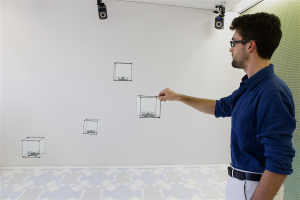
Researchers with the Human Media Lab at Queen’s University in Ontario have developed an interactive swarm of flying 3D pixels – dubbed BitDrones – that will allow users to interact with “self-levitating building blocks” exploring virtual information in physical “hologram.”
In a paper scheduled to be presented at the ACM Symposium on User Interface Software and Technology in Charlotte, N.C. this week, Professor Roel Vertegaal and students detail how they have created three types of BitDrones — “each representing self-levitating displays of distinct resolutions.”
PixelDrones consist of one LED and small dot-matrix display while ShapeDrones are made of lightweight mesh built on a 3D-printed geometric frame (think of them as the Lego blocks of the system). DisplayDrones include a curved, flexible hi-res touchscreen, video camera and Android circuit board.
“All three BitDrone types are equipped with reflective markers, allowing them to be individually tracked and positioned in real time via motion capture technology,” Vertegaal said in a media release. “The system also tracks the user’s hand motion and touch, allowing users to manipulate the voxels in space.”
“BitDrones brings flying programmable matter, such as featured in the futuristic Disney movie Big Hero 6, closer to reality,” Vertegaal added. “It is a first step towards allowing people to interact with virtual 3D objects as real physical objects.”
In a demonstration, users can explore a physical “file folder” by touching the folder’s associated PixelDrone. The folder “opens,” allowing a user to see its contents represented by PixelDrones flying in a “horizontal wheel” below it. The drones can literally be swiped left or right to browse files.
“We call this a Real Reality interface rather than a Virtual Reality interface. This is what distinguishes it from technologies such as Microsoft HoloLens and the Oculus Rift: you can actually touch these pixels, and see them without a headset,” Vertegaal said.
Currently the system only allows for a dozen or so 2.5-5.5-inch drones; however, the team hopes to scale up to support thousands of drones.
“These future drones would measure no more than a half inch in size, allowing users to render more seamless, high resolution programmable matter.”
Jason is a longstanding contributor to DroneLife with an avid interest in all things tech. He focuses on anti-drone technologies and the public safety sector; police, fire, and search and rescue.
Beginning his career as a journalist in 1996, Jason has since written and edited thousands of engaging news articles, blog posts, press releases and online content.
Email Jason
TWITTER:@JasonPReagan
Subscribe to DroneLife here.